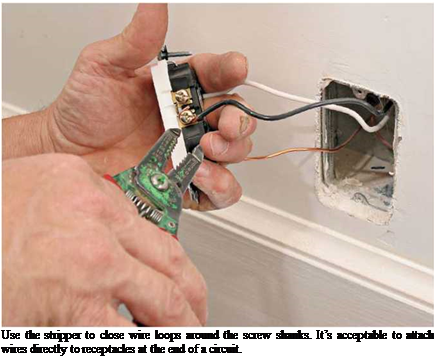INSTALLING A GFCI RECEPTACLE
Important: Read earlier sections about installing standard receptacles before installing a GFCI receptacle. As already mentioned, the NEC requires GFCI protection in the following locations: all bathroom receptacles; all kitchen counter receptacles; kitchen receptacles within 4 ft. of a sink; all outdoor receptacles; accessible basement or garage receptacles; and receptacles near pools, hot tubs, and the like.
О Shut off power to the outlet and test with a voltage tester to be sure it’s off. Carefully read the instructions that come with your GFCI. Devices vary, and your warranty—and your safety — depends on your installing the device correctly. GFCI receptacles are amperage rated (15 amp and 20 amp) and should match the cable wire size and be correctly sized for the circuit load.
GFCIs are wired in essentially the same manner as standard receptacles—hot wires to gold screws, neutral wires to silver screws, ground wire to grounding screw—except here you’ll need to know which incoming cables are line wires (from the power source) and which are load wires (running on to the next outlet). So disconnect the old receptacle while the power is off and separate wires from each other. Temporarily turn the power back on and—being careful not to touch the bare wire ends—use a voltage tester to determine which pair of wires are "line.” That done, turn the power off again and use white tape and a felt – tipped pen to denote "LINE” and "LOAD” wires.
Attach the wires running from the power source to the screw terminals or wire leaders marked "LINE,” attach wires continuing to the next outlet to the terminals or leaders marked "LOAD,” and attach ground wires to the terminal or leader marked "GROUND” and (if it’s a metal box) to the pigtail that grounds the box. If there are no outlets downstream, use wire nuts to cap the two load leaders.
When connections are completed, gently press the device into the outlet box, screw the receptacle to the outlet box, install the cover plate, and turn the power back on. Then test the GFCI by pressing its "on”or "test” button, per the manufacturer’s instructions. If the device won’t stay on or

 |
devices downstream don’t work, you have either a short circuit or a defective GFCI. Most makers recommend testing the devices once a month. All GFCI receptacles used outdoors must be housed in gasketed, weatherproof boxes with covers.






Leave a reply